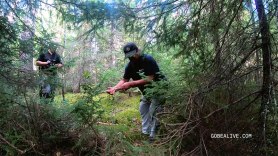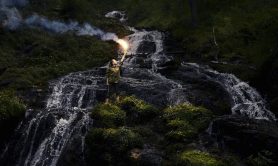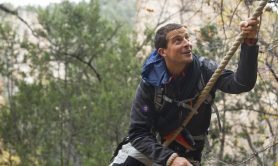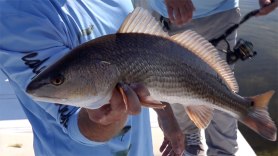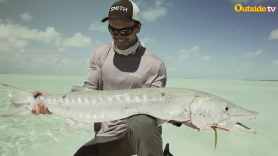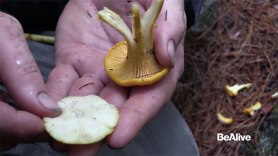

The #18 elk hair caddis hovered in the air for a split second, having reached the end of the nine-foot leader and the 30-foot fly line that had been cast to the far bank. It fluttered down to the surface of Young’s Creek as if it had dropped out of the overhanging spruce tree that shadowed the pool, joining the real spruce budworm moths that littered the top of the water.
Videos by Outdoors with Bear Grylls
Slowly Mary Gayle’s creation (life is good when your wife ties flies) slid along a seam in the current between the quick thread and the back curl, bobbling in the tiny waves created by the water rushing over a stoney bottom, disappearing every so often in the foamy wash. The almost-white hackles rocked slowly along the surface, sliding softly toward the deep hole near the middle of the pool. The creek bed was a jumble of pastel-colored sandstones — greens, blues, browns, and oranges, all appearing to be only inches under the surface because of the crystal clearness of the spring-fed stream.

Through the depth of wavy air masquerading as water, I saw the big cutthroat trout twitch his tail just a bit to ease away from a tangle of sun-bleached logs and root systems mashed between two large boulders. Then his fins squared him to his next task as he gently rose up through four feet of water to take what he thought was going to be a tasty breakfast treat.

He barely opened his mouth as he sipped in my fly. With a quick upward flip of my right wrist and a sideways drop of my left, line-filled hand, I set the barbless hook. Twenty inches of spotted, red-bellied wonder slashed sideways and fled downstream trying to rid himself of the point that had been driven into his jaw.
As the cutthroat neared the shallow end, he made a wide circle as if at the end of his arena, and, gathering speed, roared up the near bank, right at me. I was now scrambling to strip in the line to keep the whole rig taut, as a barbless hook will pop out if there is not constant pressure to keep it in place. The gather of the line that was now between my hand and the reel floated downstream and was in serious jeopardy of getting tangled with the on-coming trout. Pinching the line to the cork, I raised my rod hand way above my head and started reeling like a madman with my left, trying to get the wayward stripping onto the reel.
My Predicament
I could hear Jack Rich, the owner of the Rich Ranch, giggling in the background at my predicament. He stood there knee deep in his Montana waders (dungarees and sneakers) with a big stained cowboy hat pushed back on his forehead, watching me battle this beautiful fresh fish.
The cutthroat obligingly went a bit right, streaking up the center of the run, fighting as fast as he could to the head of the long pool. This was no jump in the air and throw water type. This big fish just wanted to power down along the bottom and beat me with his muscle. The beautiful Ray Cote 3-wt. bent to the task, absorbing the slashes while providing enough backbone to wear on the fish. The sensitive tip let me feel every movement as this magnificent wild trout tried to throw the fly.

He slid into the gravel bottom that had collected at the drop at the end of the riffle that marked the entry to the run and started to rub his jaw along the stones, trying to dislodge the hook. I raised the rod tip and tilted his head up off the rocks.
He started to tire. As I slid him over to me, I could see his beautifully spotted sides heaving in and out as he tried to get oxygen into his lungs. With a quick twist, I removed the hook and watched with delight as the big fish gathered himself and shot off, only to disappear under the logjam from which he had originally come.
“I thought he had you there for a minute,” said a grinning Jack. “You are lucky he jigged right when he got to your feet!”
“Had him under control the whole time,” I lied. “Just testing his skill.”
The Rich Family
For five generations the Rich family has made a living in Montana with horses and mules. Starting during the Civil War hauling freight, they soon moved into ranching and horse training. For the last 60 years, they have been involved in guest ranching and Bob Marshall Wilderness (The Bob) pack trips. Jack’s dad, the legendary C.B. Rich, was a leader in the conservation movement in Montana and a life-long packer. His love of the land has been passed on to the current leader of the clan. Jack is joined by his wife Belinda, their three children, and his sister Peggy and her daughter and granddaughter, making the Rich Ranch a true family affair.
Their ranch is located near Seely Lake, Montana, a small town just outside the southwest corner of the wilderness area. A true four-seasons operation, they offer guided pack trips in the summer, elk hunting pack trips in the fall, snowmachine rides in the winter, day rides for guests who stay in their modern cabins, and three squares a day in the main lodge,
J.P. Dunn, Lincoln Williams, and I were joined by two couples Kim and Troy Dunn (no relation) and Sam and Marc Fortunato for a 10-day fly fishing trip that most of us only dream about. Our outfit was complemented by two packers, a cook with an assistant, Jack, 12 horses, and 15 mules.

The Great Bear Wilderness, the Bob Marshall Wilderness, and the Scapegoat Wilderness form the Bob Marshall Wilderness Complex, an area of more than 1.5 million acres that is half as big as Rhode Island. Only one main road separates this giant area from the Glacier National Park. The 1,850-mile trail system is open only to foot and horse traffic. Everything has to be packed in and taken out. There can be no motorized or mechanized equipment in the area — no bikes, no chainsaws, no snow machines, no wagons, no roads, no logging, and no mining. The only thing you hear is the creaking of the saddle, the chirping of the birds, and the bugling of the bull elk.

Imagine a 180-mile long drainage that is shaped like an elongated U that is oriented with the open end to the north. We left the trailhead and rode all morning up over Pyramid Pass. We lunched at a small mountain lake and then dropped down into the valley.
Our first night, some 16 miles into the wilderness, was at the site Jack uses for his very successful elk and deer hunting operation in the fall. In the morning we were treated to seeing a herd of some 20 elk, several with impressive racks, grazing about a half mile above us on a very steep, flower-covered slope. After a great pancake feast, the sure-footed, gentle mountain horses were saddled, the mules packed, and we got ready to head down the valley.

“I just got off the SAT phone with Belinda,” said Jack “There are several forest fires blazing just outside the Wilderness Area to the southwest. They are big and they are spreading quickly. They have burned out Pyramid Pass, the one we came in on, and they are making their way along the valley near Seeley. I am not sure yet whether or not we will be able to go out our planned exit through the Carson Pass to the west. The good news is that, given the wind direction, it does not seem the fires will work their way over the mountains. We can always get the boys to meet us at a trailhead to the southeast if we have to. There is nothing we can do, so let’s go fishing!”
Amazing Journey
We crossed thirteen named streams to get to a flat about a mile above where the Young joins the Danaher to make the headwaters of the South Fork of the Flathead River. It was here we started fishing in earnest. In one morning we worked only six pools. In those runs were enough 18-21″ cutthroat trout to keep our lightweight equipment bent most of the time. What was mind-boggling is that this kind of fishing extends down through the whole valley with very few anglers working the water.
The spruce budworm moths were hatching. The air was just full of their flitting bodies as they hovered over the water. In a matter of minutes, we were really into the fish. J.P. found a hole that was right out of a painting. Where the creek took a left-hand bend, two uprooted trees about 12 feet apart were cocked sideways down into the stream. We could see the wavering shapes of several big cutthroat trout in about four feet of water, their bodies making winking shadows on the beautifully colored sandstone rocks beneath them. The trick was going to be how to get the fly to float through the hole without getting caught in the now weathering branches.
He dropped his elk hair caddis just upstream of the whole mess, guided it along in the current that swirled around the tip of the first tree and let it glide into the hole between the two. There was a swirl as the big cutthroat slammed into his offering. With practiced ease, J.P. set the hook and the fight was on. The big fish tried to disappear under the downstream tree, but J.P. was having none of that. Using the power of his 4-wt. rod and 5x tippet, he muscled him out and around the head of the obstacle and pulled him into the more open water on the west side of the run. Here the 20-inch fish thrashed about as he tried to rid himself of the hook. In a few minutes he tired and J, P. brought him to the shore.

We fished hole after hole as we waded slowly upstream in the gathering evening light, each spot giving up its native sons to our artificials. Each time we returned them to the water, setting them free to grow a little bigger for the next time we would see them.
That night I sat alone on a log watching the fading embers of a lodge-pole pine fire, the Big Dipper pouring blackness into the all-consuming night that covered the Bob Marshall Wilderness Area. My fellow travelers were all ensconced in their Cabelas tents and mummy sleeping bags, delightfully tired from a day of riding and fishing.
This is why I travel to remote places, not to be alone for I can be alone in a crowd, but to listen to the rhythm of the natural world. As Jack Rich put it, to hear the “…hush of the wilderness.”
But hush does not mean quiet. It is the mewing of the elk in the meadow above the camp at night as mothers talk to their young — the thrumming of the forest fire-dead trees and root systems, natural tuning forks for the strong westerly winds that bring the smell of smoke from the huge forest blaze just over the mountains and, the slap of a beaver tail in the burbling waters of a wide spot in the creek.
Raising my head to the twinkling lights that had traveled millions of miles to greet me, I realized that dimensions in the wilderness are different; immensities are counter-balanced by the tininess of the human being. The dark night was the smooth river that blended present time with time beyond time, a stream of movement without dimension and end. It is here in “the hush of the wilderness” that I find my peace.



